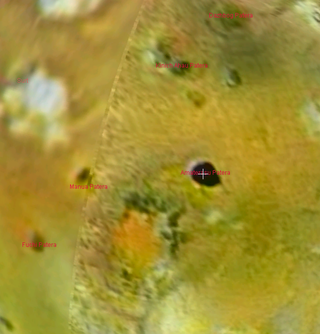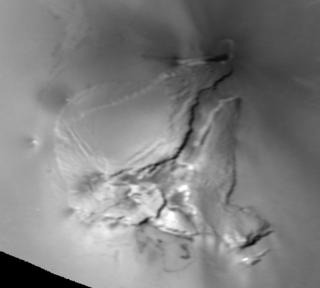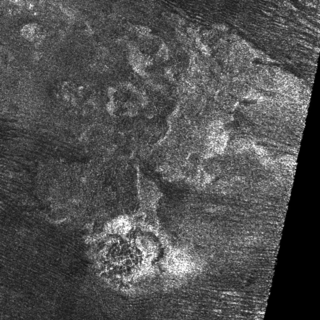
Amaterasu Patera is a patera, a complex crater with scalloped edges, on Jupiter's moon Io. It is one of the darkest features on Io, and the measurement of its thermal spectrum helped to support an anticorrelation between albedo and temperature for Ionian hotspots. The feature has darkened further since the first orbit around Jupiter by the Galileo spacecraft. It is 100 kilometers in diameter and located at 38.1°N 306.5°W. It was named after the Japanese sun goddess Amaterasu. To the north are Kinich Ahau Patera and Dazhbog Patera, and to the west are Manua Patera and Fuchi Patera.

Asha Patera is a patera, or a complex crater with scalloped edges, on Jupiter's moon Io. It is approximately 108 kilometers in diameter and located at 8.84°S 225.69°W. It is named after asha, the Zoroastrian principle of Truth. Its name was adopted by the International Astronomical Union in 1979. Reiden Patera and Kami-Nari Patera can both be found to the west.

Kami-Nari Patera is a patera, or a complex crater with scalloped edges, on Jupiter's moon Io. It is approximately 53 kilometers in diameter and is located at 8.7°S 235.08°W. It is named after the Japanese god of rolling thunder, Kami-Nari. Its name was adopted by the International Astronomical Union in 2000. Reiden Patera can be found to the south, and Asha Patera can be found to the east.

Fuchi Patera is a patera, or a complex crater with scalloped edges, on Jupiter's moon Io. It is approximately 66 kilometers in diameter and is located at 28.4°N 327.6°W. It is named after the Ainu fire goddess, Kamuy Fuchi. Its name was adopted by the International Astronomical Union in 1979. Manua Patera is located north-northeast, and Amaterasu Patera is located northeast.

Manua Patera is a patera, or a complex crater with scalloped edges, on Jupiter's moon Io. It is about 110 kilometers in diameter and is located at 35.78°N 321.73°W. It is named after the Hawaiian sun god Manua. Its name was adopted by the International Astronomical Union in 1979. To the southwest is Fuchi Patera, and to the east is Amaterasu Patera.

Kinich Ahau Patera is a patera, or a complex crater with scalloped edges, on Jupiter's moon Io. It is about 45 kilometers in diameter and is located at 49.35°N 310.25°W. It is named after the Mayan sun god Kinich Ahau. Dazhbog Patera is located northeast, Amaterasu Patera is located south-southeast, and Manua Patera can be found southwest.

Monan Patera is a patera, or a complex crater with scalloped edges, on Jupiter's moon Io. It is about 137 kilometers in diameter and is located at 19.82°N 104.81°W. It is named after Monan, a god in Brazilian mythology that destroyed the world with fire and floods. Its name was adopted by the International Astronomical Union in 1997.

Ah Peku Patera is a patera, or a complex crater with scalloped edges, on Jupiter's moon Io. It is 85 kilometers in diameter and is located at 10.3°N 107°W. It is named after the Mayan thunder god Ah Peku. Its name was adopted by the International Astronomical Union in 2006. Ah Peku Patera is located on the south end of Monan Mons, north of which is Monan Patera. The eruptive centers Amirani and Maui can be found northwest, as well as Maui Patera. Gish Bar Patera is located toward the northeast. Ah Peku Patera was first detected by the spacecraft Galileo's Solid State Imager and Near-Infrared Mapping Spectrometer. It is considered an active hot spot.

Gish Bar Patera is a patera, or a complex crater with scalloped edges, on Jupiter's moon Io. It is 106.3 by 115.0 kilometers and 9,600 km2 in area. It is located at 16.18°N 90.26°W. It is named after the Babylonian sun god Gish Bar. Its name was approved by the International Astronomical Union in 1997. It is located at the southern base of Gish Bar Mons, an 11-kilometer-high mountain. To the northeast is Skythia Mons, and to the east is Monan Mons, at the north and south ends of which are Monan Patera and Ah Peku Patera.

Estan Patera is a patera, or a complex crater with scalloped edges, on Jupiter's moon Io. It is 95 kilometers in diameter and located at 21.53°N 87.59°W. It is named after the Hittite sun god Estan. Its name was adopted by the International Astronomical Union in 2006. It is located at the northern base of the 11-kilometer mountain Gish Bar Mons. Located west-northwest is Skythia Mons, and to the southwest is Monan Mons, at the northern and southern ends of which are Monan Patera and Ah Peku Patera.

Shango Patera is a patera, or a complex crater with scalloped edges, on Jupiter's moon Io. It is about 90 kilometers in diameter and is located at 32.35°N 100.52°W. It is named after the Yoruba thunder god Shango. Its name was approved by the International Astronomical Union in 2000. It is located north of Skythia Mons. To the southwest is the eruptive center Amirani, and to the southeast are Gish Bar Patera, Gish Bar Mons, and Estan Patera.

Maui Patera is a patera, or a complex crater with scalloped edges, on Jupiter's moon Io. It is about 38 kilometers in diameter and is located at 16.61°N 124.23°W. It is named after Māui, a Hawaiian demigod that sought fire from Mafuike. Its name was approved by the International Astronomical Union in 1979. It is located southwest of the eruptive center Maui, south of Euxine Mons, and southwest of the volcano Amirani. Due east are Monan Patera, Monan Mons, and Ah Peku Patera.

Babbar Patera is a patera, or a complex crater with scalloped edges, on Jupiter's moon Io. It is about 86 kilometers in diameter and is located at 39.8°S 272°W. It is named after a Sumerian sun god, and its name was approved by the International Astronomical Union in 1979. Some scarps near Babbar Patera may represent faults. Immediately south of Babbar Patera is the plateau Lyrcea Planum, and further south is Svarog Patera. To the east is the mountain Egypt Mons.

Svarog Patera is a patera, or a complex crater with scalloped edges, on Jupiter's moon Io. It is 124 kilometers in diameter and is located at 48.66°S 265.74°W. It is named after the Russian smith god Svarog. Its name was approved by the International Astronomical Union in 1979. Svarog Patera is a Voyager spacecraft-detected hot spot. North of Svarog Patera is Lyrcea Planum, north of which is Babbar Patera. To the south is Silpium Mons, and to the east is Hermes Mensa. To the southeast are Pyerun Patera and Epaphus Mensa.

Pyerun Patera is a patera, or a complex crater with scalloped edges, on Jupiter's moon Io. It is about 57 kilometers in diameter and is located at 55.65°S 251.06°W. It is named after the Slavonic god of thunder, Pyerun. The name was adopted by the International Astronomical Union in 1985. West of Pyerun Patera is Mithra Patera, and to the east is the mesa Epaphus Mensa. To the northeast is Epaphus Mensa, and to the northwest are the mountain Silpium Mons and Svarog Patera.

Mithra Patera is a patera, or a complex crater with scalloped edges, on Jupiter's moon Io. It is about 34 kilometers in diameter and is located at 59.04°S 266.48°W. It is named after the Persian god of light, Mithra. Its name was adopted by the International Astronomical Union in 1985. To the north is Silpian Mons, and to the east is Pyerun Patera. Located southwest is Viracocha Patera.

Viracocha Patera is a patera, or a complex crater with scalloped edges, on Jupiter's moon Io. It is about 61 kilometers in diameter and is located at 61.75°S 280.07°W. It is named after the Quechua creator god Viracocha. The name was adopted by the International Astronomical Union in 1979. Viracocha Patera is a Voyager spacecraft-detected hot spot. To Viracocha Patera's east-northeast is Mithra Patera, and to the northeast is the mountain Silpium Mons.

Silpium Mons is a mountain on Jupiter's moon Io. It is 5.6 kilometers in height, 113 kilometers in length, and 79.7 kilometers in width. It covers an area of 7073 km2. It is a striated ridge, meaning it is an elevated structure dominated by one or more prominent linear or arcuate rises. It is named after a location in Greece where the mythological Io died of grief. Its name was adopted by the International Astronomical Union in 1979. It is located at 52.71°S 272.34°W, south of Svarog Patera, north of Mithra Patera, and northeast of Viracocha Patera. Its proximity to Svarog and Viracocha Paterae has been suggested to be evidence for a structural relationship between mountains and calderas on Io.

Danube Planum is a rifted mesa on the surface of Jupiter's moon Io. It is located on Io's trailing hemisphere at 22.73°S 257.44°W. Danube Planum is 244.22 kilometers across and 5.5 km tall. The mountain is bisected by a 15-to-25-kilometer-wide, northeast–southwest-trending canyon, splitting the mountain into two main east and west mountains, with several additional blocks at the southern end of the fracture. The outer margin of the plateau is marked by 2.6-to-3.4-km-tall scarps. Mass wasting in the form of landslide deposits are visible along the base of the western half of Danube Planum. Two volcanic depressions, known as paterae, lie at northern and southern ends of mountain. The volcano at the northern end, Pele, is one of the most active volcanoes on Io. One of the faults that helped form Danube Planum may also act as a conduit for magma to rise to the surface at Pele.

Doom Mons is the name of a mountain range and its eponymous peak on Titan, the largest moon of Saturn. A putative cryovolcano, it is the largest mountain range on Titan by volume. It was discovered by the Cassini–Huygens probe in 2005 and officially named in 2012.












